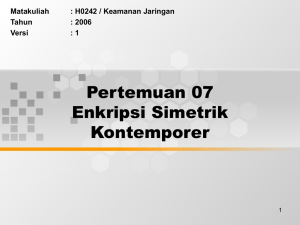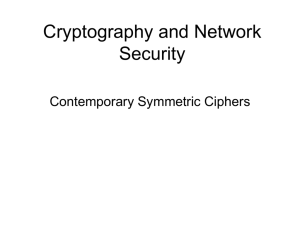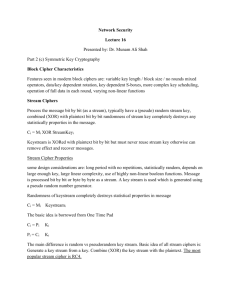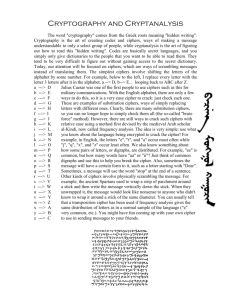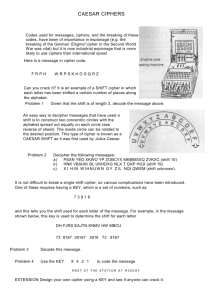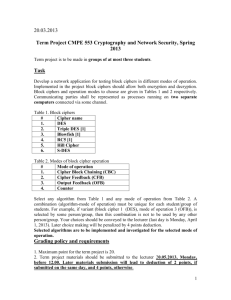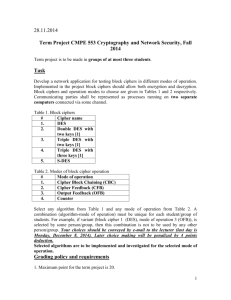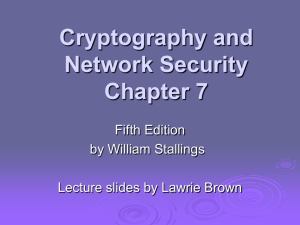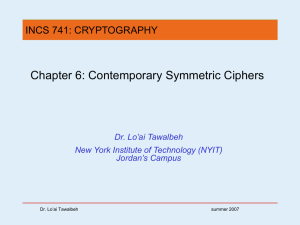Slides
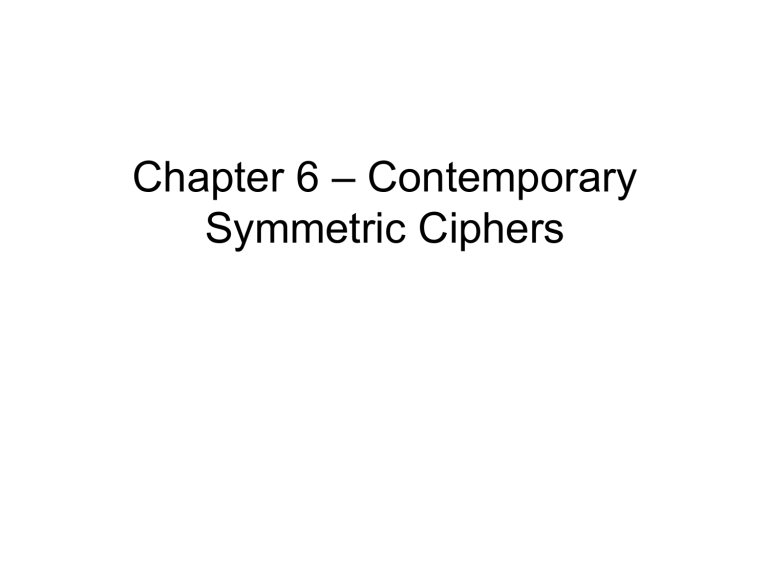
Chapter 6 – Contemporary
Symmetric Ciphers
Triple DES
• A replacement for DES was needed
– theoretical attacks that can break it
– demonstrated exhaustive key search attacks
• AES is a new cipher alternative
• Before AES alternative
– use multiple encryptions with DES
• Triple-DES is the chosen form
Why Triple-DES?
• why not Double-DES?
– NOT same as some other single-DES use, but have
• meet-in-the-middle attack
– works whenever use a cipher twice
– since X = E
K1
[P] = D
K2
[C]
– attack by encrypting P with all keys and store
– then decrypt C with keys and match X value
– can show takes O(2 56 ) steps
Triple-DES with Two-Keys
• hence must use 3 encryptions
– would seem to need 3 distinct keys
– Key of 56 X 3 = 168 bits seems too long
• but can use 2 keys with E-D-E sequence
– C = E
K1
[D
K2
[E
K1
[P]]]
– No cryptographic significance to the use of D in the second step
• standardized in ANSI X9.17 & ISO8732
• no current known practical attacks
– some are now adopting Triple-DES with three keys for greater security
Triple-DES with Three-Keys
• although are no practical attacks on twokey Triple-DES have some indications
• can use Triple-DES with Three-Keys to avoid even these
– C = E
K3
[D
K2
[E
K1
[P]]]
• has been adopted by some Internet applications
Blowfish
• a symmetric block cipher designed by
Bruce Schneier in 1993/94
• characteristics
– fast implementation on 32-bit CPUs, 18 clock cycles per byte
– compact in use of memory, less than 5KB
– simple structure for analysis/implementation
– variable security by varying key size
• Allows tuning for speed/security tradeoff
Blowfish Key Schedule
• uses a 32 to 448 bit key
• used to generate
– 18 32-bit subkeys stored in P-array: P1 to P18
– S-boxes stored in S i,j,
• i=1..4
• j=0..255
Blowfish Encryption
• uses two primitives: addition & XOR
• data is divided into two 32-bit halves L
0 for i = 1 to 16 do
& R
0
L
17
R
17
R i
L i
= L i-1
XOR P i
;
= F[ R i
] XOR R i-1
;
= R
16
= L
16
XOR P
XOR i
18
17
;
;
• where
F[ a , b , c , d ] = ((S
1, a
+ S
2,b
) XOR S
3,c
Break 32-bit R i into (a,b,c,d)
) + S
4, a
Discussion
• provided key is large enough, brute-force key search is not practical, especially given the high key schedule cost
• key dependent S-boxes and subkeys make analysis very difficult
– Very few cryptoanalysis results on blowfish
• changing both halves in each round increases security
– Some study shows improved avalanche effects
RC5
• can vary key size / input data size /
#rounds
• very clean and simple design
• easy implementation on various CPUs
• yet still regarded as secure
– Vary parameters to achieve tradeoffs
RC5 Ciphers
• RC5 is a family of ciphers RC5-w/r/b
– w = word size in bits (16/32/64) data=2w
– r = number of rounds (0..255)
– b = number of bytes in key (0..255)
• nominal version is RC5-32/12/16
– ie 32-bit words so encrypts 64-bit data blocks
– using 12 rounds
– with 16 bytes (128-bit) secret key
RC5 Key Expansion
• RC5 uses 2r+2 subkey words (w-bits)
– Two subkeys for each round
– 2 subkeys for additional operations
• subkeys are stored in array S[i] , i=0..t-1
• Key expansion: fill in pseudo-random bits to the original key K
• Certain amount of one-wayness
– Difficult to determine K from S
RC5 Encryption
• split input into two halves A & B
L
0
R
0
=
=
A
B
+ S[0];
+ S[1]; for i = 1 to r do
L i
R i
= (( L i-1
= (( R i-1
XOR R i-1
) <<< R i-1
) + S[2 x i ];
XOR L i
) <<< L i
) + S[2 x i + 1];
• each round is like 2 DES rounds
• note rotation is main source of non-linearity
• need reasonable number of rounds (eg 12-16)
• Striking features: simplicity, data-dependent rotations
RC5 Modes
• RFC2040 defines 4 modes used by RC5
– RC5 Block Cipher, is ECB mode
– RC5-CBC, input length is a multiples of 2w
– RC5-CBC-PAD, any length CBC with padding
• Output can be longer than input
– RC5-CTS, CBC with padding
• Output has same length than input
Block Cipher Characteristics
• features seen in modern block ciphers are:
– variable key length / block size / no rounds
– mixed operators
• data/key dependent rotation
• key dependent S-boxes
– more complex key scheduling
• Lengthy key generation, simple encryption rounds
– operation of full data in each round
Stream Ciphers
• process the message bit by bit (as a stream)
• typically have a (pseudo) random key stream
• combined (XOR) with plaintext bit by bit
• randomness of key stream completely destroys any statistically properties in the message
– C i
= M i
XOR StreamKey i
• what could be simpler!!!!
• but must never reuse key stream
– otherwise can remove effect and recover messages
Block/Stream Ciphers
• Stream ciphers
– For applications that require encryt/decryt of a stream of data
– Examples: data communication channel, brower/web link
• Block ciphers
– For applications dealing with blocks of data
– Examples: file transfer, e-mail, database
• Either type can be used in virtually any application
Stream Cipher Properties
• some design considerations are:
– long period with no repetitions
– statistically random
– Highly nonlinear correlation
RC4
• variable key size, byte-oriented stream cipher
• widely used (web SSL/TLS between browser and server, wireless WEP)
• key forms random permutation of a 8-bit string
• uses that permutation to scramble input info processed a byte at a time
RC4 Security
• claimed secure against known attacks
– have some analyses, none practical
• result is very non-linear
• since RC4 is a stream cipher, must never reuse a key
Summary
• have considered:
– some other modern symmetric block ciphers
– Triple-DES
– Blowfish
– RC5
– briefly introduced stream ciphers
